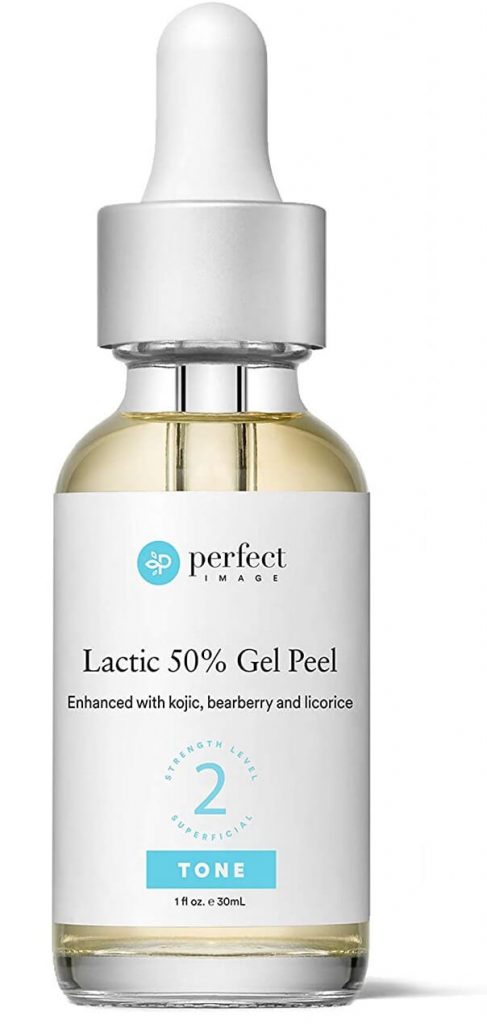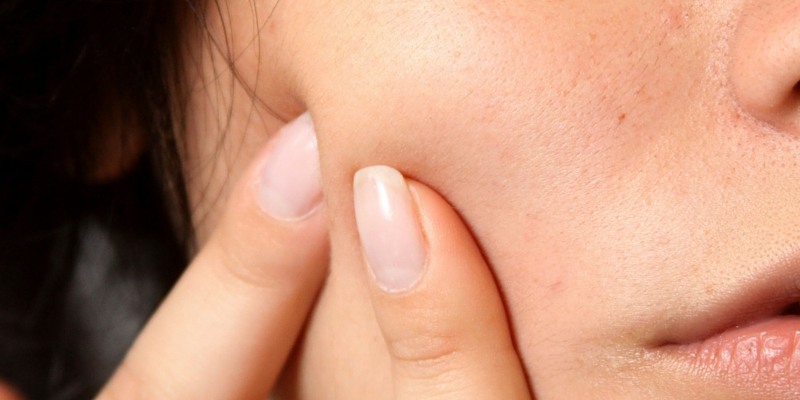After you’ve managed to treat your acne you may have noticed there’s still some “unfinished business” left for you to take care of.
Unfortunately, acne often leaves behind red or purplish little marks known as post-inflammatory hyperpigmentation or simply discoloration. If you have darker skin, these spots will likely also be darker in color.
The most frustrating thing about these post-acne marks is that they can take months or even years to fade on their own. Usually, the more severe or deeply rooted your acne was, the longer they’ll take to heal.
Hyperpigmentation vs. Scarring
One thing to note is that post-inflammatory pigmentation is different than scarring even though the two are commonly confused and used to refer to each other.
Acne scars leave behind tiny dents in your skin and are usually called “ice pick” scars. There are also “boxcar”, “rolling”, and “pitted” types of scars which refer to the shape of the indentation. Scars can either be permanent or semi-permanent whereas discolored marks are only temporary. In other words, scars last longer.
The marks that form are a natural part of the skin’s response to inflammation. Your best bet is to prevent them from forming in the first place. And the best way to do that is by not aggravating your acne while you still have it. Touching your face or picking at pimples can further inflame them. If your pimple or acne hurts to the touch then you need to be especially careful because they’re the most prone to leaving behind marks.
For the same reason, you should also avoid using physical exfoliants like scrubs and stick to chemical or homemade masks instead.
Begin treating your acne as soon as you notice it forming (whether with benzoyl peroxide, tea tree oil, patches, etc.). Don’t give it a chance to mature and plant deep roots within your skin. The sooner you get rid of the pimple the better. When you don’t have acne there’s no chance of a mark getting left behind either.
Avoiding the sun or using sunscreen is also crucial to speed up the healing process. UV light, as you already know, darkens skin including your already darkened hyperpigmented spots taking them longer to fade away on their own.
That being said, we aren’t the biggest fans of just sitting around and waiting for things to happen on their own. We want to see results now. Or at the very least jump start the recovery process and look our best sooner rather than later.
So what can you do to treat acne scars and discoloration?
4 Acne Treatments Requiring a Specialist
Each of the following treatments require a specialist who can handle the equipment necessary to treat your scars.
If you’d like to take things into your own hands and try at home methods to save money stay tuned for the second part of this guide (found here) where we’ll go over the the best skincare ingredients to specifically treat discoloration.
1) Dermabrasion
Use For: Scars and Discoloration
Dermabrasion is a method which basically sands away the outermost layers of the skin, evening out the surface to become smoother.
Microdermabrasion uses tiny crystal like grains that act as exfoliators. They’re sprayed on to your skin and they help remove the outermost skin cells (the pigmented ones in this case) to reveal the newer, younger ones underneath. Your body interprets this as damage and it rushes to heal the area, thus letting the mark or scar fade quicker.
Dermabrasion is harsher on the skin than microdermabrasion. They both usually require multiple sessions to get satisfactory results.
Whether these will specifically help your skin isn’t quite clear. We wish we could say these worked for everyone but that’s not the case. Some people report only seeing temporary results for a few days after treatment before their skin returns to normal. They will help brighten up your face at the very least with their exfoliating properties but most people won’t see drastic improvements on their scarring that quick. Especially if they’ve only attended a couple sessions. Repeated sessions are needed for these to really work.
A lot of this also depends on the skill of the person performing this procedure. We recommend searching for reviews online for someone with a proven track record. Would you trust someone who doesn’t know what they’re doing to basically shave the outermost layer of your skin? Of course not. You want the best results possible. Your skin deserves it.
After a session, your face will be swelled and turn pinkish usually for a period of up to 24 hours. You should do your best to avoid any sunlight during this time because your skin will be more susceptible to UV damage than usual. Definitely make sure to moisturize and use sunscreen after one of these treatments.
2) Dermal Fillers
Use For: Scars Only
The FDA recently approved the first dermal filler to treat the ice pick type of acne scarring we mentioned earlier and are quickly becoming a viable option to treat acne scars. Dermal fillers are injected into the skin and work by “plumping” up the area with atrophy and “filling” in the dent. They also stimulate collagen production which helps improve the skin’s elasticity.
Most dermal fillers are based on hyaluronic acid which is a naturally occurring substance in the body and like collagen, helps support the structure of the skin.
They work best on shallower scars and last at most about a year or so before you need to replace them. Permanent fillers aren’t even recommended because your skin naturally changes its elasticity over time. This means they wouldn’t look as great as when you first get them. They’re also pretty expensive ranging from hundreds to even thousands of dollars depending on the type of filler you get. On the plus side, they don’t require multiple sessions like dermabrasion or laser treatments and you’ll see immediate results after you’re done.
You should also expect some swelling and redness for a few days afterward but they quickly subsides.
Our take on fillers for acne scarring: They work and you’ll see improvement so it might be worth giving them a shot if you can afford the treatment.
3) Laser Resurfacing
Use for: Scars and Discoloration
We’re just going to say this outright — laser resurfacing isn’t our favorite method of treating post-acne scarring. If you disagree with us below make sure to leave a comment telling us why!
First of all there are actually many different types of laser treatments. Some of these include Fraxel, Smoothbeam, YAG, and CO2 lasers. The name actually refers to the type of laser technology used. Fraxel is the newest and perhaps the most sophisticated of the bunch, because not only does it resurface but it’s also supposed to promote collagen production in the skin.
Each laser has the same end goal in mind (to eventually improve the quality of your skin) and they each essentially resurface the skin by “burning” off the top layer. This may sound scary, but most of the time it just feels like a light sunburn and the pain is relatively minimal.
You’ll probably get a numbing cream beforehand to help you deal with any pain. Although, pain probably isn’t the right word. A better one would probably be “irritation” but we guess it depends on your “pain” tolerance. You may get a few tiny little red dots afterward but these aren’t that noticeable and are temporary
So after all this you may be wondering “How come you guys don’t like laser treatments?” Because some people respond to treatments better than others and the ones who DON’T respond well suffer greatly for it. There are people that report losing “fat” off their face, their skin becoming saggy, and leaving the office with worse skin than they come in with. This “fat” loss is from the skin tissue atrophying and it’s usually caused by stronger lasers.
Some people report their skin becoming permanently sensitive, others report worse scarring than before, others see no improvement at all. A quick google search should be able to get you page after page of horror stories (along with successes) of people unsatisfied with their results
Because the consequences are so severe if it doesn’t work for you and the treatment is relatively expensive we can’t recommend laser therapy when there are safer and more affordable options around.
If you do choose to get laser treatment done plan to schedule multiple sessions because one is rarely enough. It’s also VERY important to find a skilled doctor or someone who knows what they’re doing. You don’t want someone ruining your skin because they improperly handled the laser or used too high of a setting. This is powerful stuff.
You should also avoid stepping outside for about a week because once again, your skin becomes VERY sensitive to UV light.
4) Punch Excision & Subcision
Use For: Scars Only
Excision and subcision are both surgical methods of removing acne scars.
During excision, a small cut the is made to remove the scar and the wound is then closed and stitched up with a suture. It’s best used for ice pick scarring, and other deeper, open pore type of scars. This procedure often leaves newer scars behind but they’re smaller and less noticeable than the original. It takes about six weeks for the skin to fully heal.
A subcision is usually used for the “rolling” type of scars. The fibrous bands which make up the scar tissue are cut and broken down allowing the skin to form new connective tissue and bring the scar up. The skin also begins producing collagen to further even out its surface.
This may sound like it hurts but the procedure is actually relatively pain free. It usually requires about 2-3 sessions to fully complete the subcision. Once again, tinier scars may be left behind but they aren’t as noticeable.
Both punch excision and subcision are usually combined with laser treatment to help resurface the skin afterward. They usually cost about a couple hundred dollars depending on the number and the size of the scars but you should ask your doctor or dermatologist to get a quote specific to your situation.
Sometimes you just don’t want to deal with the hassle of going to a dermatologist and would rather try handling things yourself before dropping big money on treatments. We think the same and thankfully, at home treatments are often just as effective as those you get at a spa or dermatologist.
Topical Vitamins A, C, & E
Vitamins A, C , and E certainly get a lot of praise for their beauty enhancing effects but is there any merit to them? Will they really help with post-inflammatory pigmentation?
If you’ve read our acne treatments guide, you know that Accutane is basically synthetic forms of Vitamin A. Vitamin A definitely has positive benefits for the skin, as we’ve gone over in our skin nutrition guide but what about applying Vitamin A topically? Will that work? Of course! Retin-A after all, is a topical application of Vitamin A and is one of the most effective exfoliators out there as we covered in our prescription acne treatments post. It’s one of our favorite treatments for getting rid of discoloration quickly, but some people do experience irritation and a stinging sensation as side effects. Check out the link above to learn more about Retin-A before trying it.
Topical Vitamin C on the other hand, also stimulates collagen. This helps improve its elasticity and can help rebuild broken down skin tissue (aka scarring). Vitamin C also offers some minor UV ray protection which can help prevent discolored spots from turning even darker.
Vitamin C and Vitamin E are commonly paired together and they work more effectively as a combo than on their own. Vitamin E on it’s own hasn’t been shown to reduce scarring but it does help fight free radicals and other types of inflammation which is a byproduct (or maybe the cause?) of acne.
Many quality skincare products already contain one or all three of these vitamins. They shouldn’t be hard to find, just check the ingredients list.
Chemical Peels & Exfoliators
We’ve also already covered some exfoliators and chemical peels like glycolic acid and salicylic acid (link) which shed away the top layer of skin (along with the pigmented skin cells).
Here are two more that can help exfoliate and get rid of the marks:
Kojic Acid
Kojic acid is derived from a mushroom and it has only somewhat recently been discovered by scientists in Japan. The acid lightens the skin’s pigment when applied topically making it perfect for treating darker spots. It does this by limiting the skin’s melanin production which is what gives it its darker color.
Like other exfoliators and chemical peels, make sure you wear sunscreen afterward and expect some irritation in the beginning before your skin builds up a tolerance. Starting with a lower concentration helps make the irritation manageable when you first start using it.
You can get kojic acid in cream, lotion, and soap form. We prefer the soap if you’re going to be consistently using it. Just make sure you’re also moisturizing afterward.
Our recommendation: Evagloss Dark Spot Corrector Serum with Kojic Acid
Again, many people have had positive results with kojic acid but there are also people who haven’t. Unfortunately, it’s hard to decide if it will work for you before you try it yourself.
Even the best acne treatment we have available today, Accutane, doesn’t work on 100% of the people who try it.
We’re putting this out there so you can properly manage your expectations. In other words, don’t expect an overnight miracle.
Lactic Acid
Lactic Acid is an AHA (alpha hydroxy acid) type of chemical exfoliator and comes it in various forms. To best treat hyperpigmentation, you want the chemical peel form of lactic acid which ranges in concentration from about 30-70%.
They’re also commonly found in lotions and creams but at much smaller concentrations. About 5% or less which don’t work as well. We don’t think anything above a 60% concentration is necessary and 50% will be optimal for most people. As always start smaller, and work your way up to see what your skin can handle.
Lactic acid is also much gentler than glycolic acid and it’s far better for those with sensitive skin. Also, since it’s an AHA you also know it has some moisturizing properties acting as a humectant and hydrating your skin by drawing in moisture.
Like other exfoliators, your skin will become more sensitive to the sun so don’t skip out on the sunscreen! Irritation is also common at first use so don’t get discouraged thinking your skin won’t benefit. That isn’t necessarily true you just need to give it time.

Our recommendation: Lactic 50% Gel Peel by Perfect Image
The lactic acid peel above is enhanced with kojic acid to help fade everything from post-inflammatory hyperpigmentation to liver spots, freckles, and more.
—
So there you have it. The end of our acne series and the first part of our series on Skin Woes. This doesn’t mean we’re done with the topic of acne. Check out the first part of this guide which we’ll be using as a central hub for all things acne. As new research or methods are discovered, we’ll continually update it and keep you posted.
Follow us on Pinterest or Twitter to get updated as soon as we release a new article @maxmylooks!





